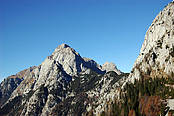Predators
Red Fox(Vulpes vulpes)
Habitat: it is widespread throughout the northern hemisphere. Foxes live mainly in the country or woods at an average height.
Identification: They generally have a slim body that reaches a length of up to 1 metre, 50 cm of which is tail, covered with a thick and soft fur in various shades, according to the species (tawny, brown, black, etc.). Its snout is pointed with slanting eyes and erect large ears. It has short and robust legs. It has a very sharp sense of smell. The fox is excellent at running and jumping.
Reproduction: they lead a nocturnal life. The female can give birth to one or more cubs.
Food: it feeds on mice, birds, dead animals, fruit. If hungry, the fox does not hesitate to enter a hen-house for food.
Stone Marten (Martes foina)
Habitat: it is widespread through Europe and central and northern Asia; it is common in Italy, except for Sardegna. It lives in the woods or near country houses, often settling in lofts, roofs or barns.
Identification: it is a small mammal of the order of carnivores, with a slim body, which is about 70 cm long including its tail, short legs, grey-brown fur with a large white patch on its chest and throat; it is an excellent climber.
Reproduction: the female gives birth to quite a few cubs during the year.
Food: it feeds on mice, rabbits, birds and chickens.
Wild Cat (Felis s. silvestris)
Habitat: it belongs to a group of small felids of the Old World, originating from the steppe - desert territories of Asia Minor. It lives in the woods.
Identification: this breed is characterised by its spotted coat on a sandy-ochreous coloured background and its tail with a black tip; its eyes are yellow green and perfectly round; just as important are its sharp hearing and sense of smell.
Reproduction: sexual maturity is reached within the first year of age. Birth is given after 62 - 63 days from mating; the female gives birth to 2 to 4 kittens, but can reach 8.
Food: it mainly feeds on rodents, particularly mice.
Euroasiatic Lynx (Lynx Lynx)
Habitat: it is a territorial animal, occupying extremely vast areas, on average about 200 square km, per individual.
Identification: camouflaged face with "large sideburns", tufts of hair on the ears and a short tail with a completely black tip. Its length goes from 90-100 cm, plus 20 cm of tail; height to the withers 50-75 cm; weight between 15 and 30 kg. The colour of its coat varies from reddish shades to cream, the bottom part is light, and its spots are variable but well seen.
Reproduction: the couples of this species meet only during the mating season, in February and March; from one to three cubs are born after 70 days and they remain with their mother for about ten months before looking for their own territory.
Food: The lynx is a pure carnivore and feeds on the animals that it manages to hunt, generally ungulates of an average size (roebuck and chamois), but also the deer, hare, fox and only on exceptional occasions a bird or small rodent.
The lynx is of absolutely no danger to man.







